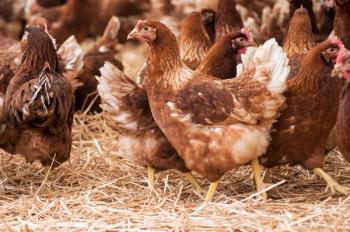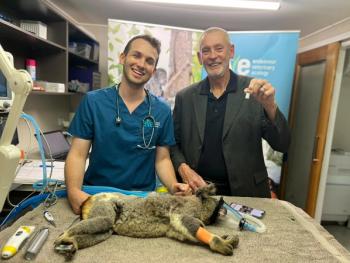
Update on canine viral diseases: Distemper and parvovirus (Proceedings)
Distemper is very contagious disease of dogs that may involve the gastrointestinal, respiratory and/or neurologic systems.
Canine Distemper
Distemper is very contagious disease of dogs that may involve the gastrointestinal, respiratory and/or neurologic systems. Although widespread vaccination of the dog population has reduced the incidence of this disease, distemper still occurs sporadically, even in vaccinated dog populations. There is some suggestion that disease may be re-emerging. Because some dogs may be show signs of respiratory disease alone, canine distemper is an important differential for kennel cough.
In vaccinated dog populations, as is typical in developed countries, distemper is most common in dogs aged 3 to 6 months of age, as maternal antibody wanes. However, in poorly vaccinated dog populations, dogs of all ages may be affected.
About 50% of dogs develop neurologic signs, but development of these signs is unpredictable. Dogs developing nasal and digital hyperkeratosis usually have neurologic complications, and dogs that develop impetiginous dermatitis (a measles-like rash), considered a favorable prognostic sign, rarely have CNS disease. Once neurologic signs occur, they are generally progressive despite treatment.
Occasionally, distemper inclusions may be seen on close examination of peripheral blood smears. These can occur as blue, round, eccentrically placed inclusions within red blood cells; or gray oval structures within lymphocytes and less commonly neutrophils and monocytes. Determining the anti-CDV IgG level in CSF can also be helpful. Comparing the distemper IgG titre in CSF with that in serum and calculating the C coefficient (see below) can also be helpful to predict whether local antibody production has occurred in the CSF.
C coefficient = (CSF anti-CDV IgG/serum anti-CDV IgG) x (serum anti-ICH IgG/CSF anti-ICH IgG). C > 1 suggests local antibody production.
In dogs with acute (usually first week or two of signs - rarely more chronic) distemper, scrapings of the conjunctival sac may show inclusions within conjunctival epithelial cells. Sensitivity is increased using immunofluorescence can be on these smears. IFA techniques can also be used on cells in CSF, blood, bone marrow, and urine sediment, and on tissue samples at postmortem to confirm the diagnosis. It can also be applied to frozen sections of hyperkeratotic pads. RT-PCR assays for detection of viral nucleic acid have been shown to be very sensitive and specific for antmortem diagnosis of distemper using serum, whole blood and CSF.
Treatment is symptomatic. Some clinicians have had success treating myoclonus with procainamide (10-20 mg/kg q12h), which seems to inhibit the firing of the motor neurons. Anticonvulsants such as phenobarbital may also be helpful.
Current vaccine recommendations are to vaccinate every 3-4 weeks between 6 and 16 weeks of age. Two doses of vaccine are necessary for adequate protection in puppies presenting when they are 8-10 weeks or older. Thereafter, a booster is recommended at one year then every 3 years. All commercially-available canine CDV vaccines are MLV vaccines, as killed whole virus vaccines do not produce sufficient protection. However, a recombinant canarypox-based CDV vaccine is commercially available in the US.
Canine Parvovirus Infection
Parvovirus infection remains one of the most common infectious disorders of dogs. Canine parvovirus emerged in the late 1970s and caused a worldwide pandemic of illness in dogs. It was initially thought that it may have emerged from FPV, but that now seems unlikely based on the differences between them. Canine parvovirus is caused by canine parvovirus 2. CPV-2 has mutated to CPV-2a, CPV-2b, and CPV-2c since it first appeared, and these latter viruses predominate in dogs currently. With this mutation, the virus has developed the ability to replicate readily in feline cells, and it now appears that CPV may now be causing some cases of feline viral enteritis, which are being increasingly recognized, perhaps because of poor vaccine cross-reactivity. A study from the UK showed that parvovirus accounted for 25% of kitten mortality. Concern has been raised about the ability of the current CPV vaccines to protect against newer CPV strains such as CPV-2c, but one recent study showed good protection against experimental challenge with CPV-2c.
Research into coagulation problems in dogs with parvoviral gastroenteritis suggests that many dogs may actually be hypercoagulable, rather than having DIC; the platelet count has typically been normal. Many dogs had evidence of venous thrombosis or phlebitis in association with catheters. Leukopenia results from sequestration of neutrophils within the gut as well as bone marrow destruction. The concurrent presence of leukopenia is highly supportive of the diagnosis, but severe gastrointestinal signs and leukopenia can also occur with other severe infections of the gastrointestinal tract, particularly salmonellosis. Shedding continues for up to 6 weeks after recovery, and most infectious disease experts recommend isolating dogs for about a month after discharge from hospital.
Parvovirus myocarditis now appears to be a rare condition because of protection of pups by maternal antibody, but still occasionally occurs in pups born to isolated, unvaccinated bitches. Investigators have been looking at DCM cases for evidence of parvoviral DNA but so far it seems that CPV-2 is not associated with DCM in adult dogs.
Neurologic signs may occur in dogs with parvovirus. These may result from intracranial hemorrhage secondary to DIC, hypoxia due to myocarditis, or profound hypoglycaemia. With the use of PCR, parvovirus has now been detected in both dogs and cats with cerebellar hypoplasia.
False positive results with the fecal ELISA may occur 5 to 12 days after vaccination with an MLV vaccine. Negative results do not completely rule out canine parvovirus infection, because virus is often not present in the stool 5 to 7 days after the onset of clinical illness.
The fecal ELISA developed for detection of CPV-2 will also detect FPV.
PCR has also been used as a sensitive and specific method of detecting viral DNA in tissues, and has been used to detect CPV-2 and FPV. PCR has been used to distinguish between wild type CPV-2 and vaccine CPV-2.
Other treatments that have been examined for CPV infection include anti-endotoxin, rhG-CSF, recombinant bactericidal/permeability increasing protein (rBP121) and recombinant feline interferon-omega. Anti-endotoxin, rhG-CSF and rBP121 have not been shown to be convincingly beneficial, and are expensive. In fact, one study showed that treatment of dogs less than 16 weeks of age with anti-endotoxin was actually associated with a higher mortality. Dogs with parvovirus infection are expected to and do have high levels of endogenous G-CSF anyway. Recombinant feline interferon-omega has been shown to be of benefit in experimentally infected dogs, but it has not been used yet to treat dogs with natural infections. A recent study showed early enteral nutrition via NE tube 12 hours after admission resulted in earlier clinical improvement and significant weight gain compared with using NPO until vomiting had ceased for 12 hours.
Canine Parvovirus Vaccine Recommendations
Prior to 1994, as many as 20% of dogs retained sufficient maternal antibody to interfere with parvovirus vaccination. Since then, a new generation of parvovirus vaccines have been introduced that produce superior immunity, and these have reduced the window of vulnerability down to a few days to two weeks. Killed CPV-2 vaccines produce a weaker response, and should not be used in contaminated environments, because the window of vulnerability is too great. Current vaccination recommendations are to vaccinate every 3 weeks from 4-6 weeks of age to 14 to 16 weeks of age. After the first annual booster, vaccination should be repeated every 3 years. A puppy that recovers from CPV-2 enteritis is immune for at least 20 months after infection, and possibly for life.
Newsletter
From exam room tips to practice management insights, get trusted veterinary news delivered straight to your inbox—subscribe to dvm360.






